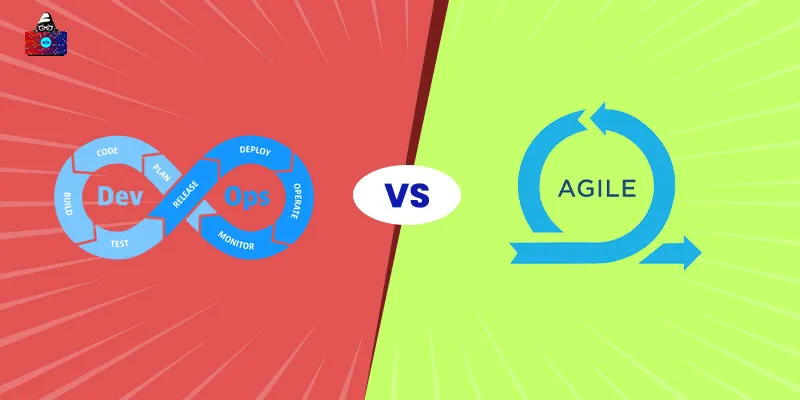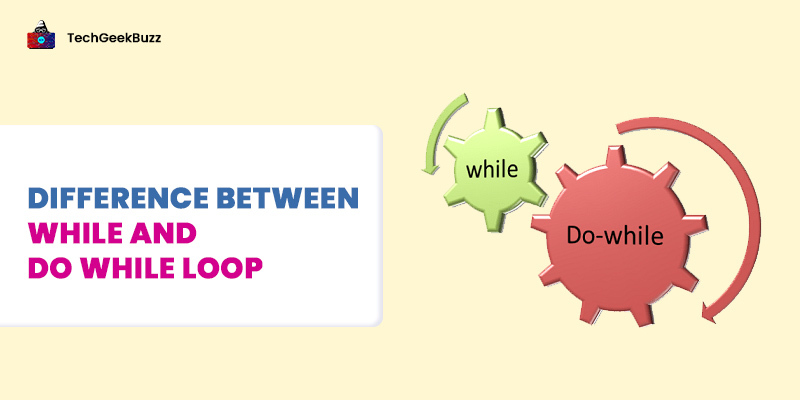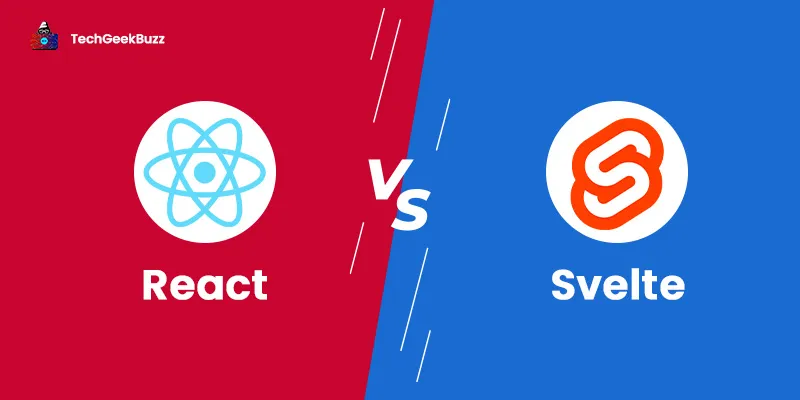The software development industry has come a long way with three significant milestones. The first milestone was the introduction of the waterfall model, the second was the agile model, and the third was the DevOps model. All these three models are highly popular approaches to software development.
Agile and DevOps methods are extensively used software development approaches these days. Both these approaches share the same aim of developing high-quality software products quickly and efficiently. But there are a lot of differences between agile and DevOps.
Well, in this article, we shall discuss the significant differences between Agile and DevOps software development methods. Also, we shall walk you through a brief introduction to Agile and DevOps, along with their principles, advantages, and disadvantages.
So, here it goes!
What is Agile?
Agile is one of the most widely employed approaches to software development and project management. It is an iterative and time-boxed approach that focuses on delivering a software product incrementally rather than delivering it at once. We can think of the agile approach as a continuous process of planning, executing, and evaluating until a software product is developed that meets stakeholders' or customers’ requirements.
The primary idea behind the agile approach is dividing a project into small chunks of user functionality, called user stories, prioritizing them, and then delivering those user stories continuously to end-users in a short time of two to three weeks, called iterations. In an agile approach, developers and testers work concurrently to deliver user stories to customers or stakeholders.
Every iteration or phase in the agile approach involves the collaboration of developers, testers, and stakeholders, where they communicate the progress of a software product under development. Also, the development team can make changes to the software product throughout its lifecycle. In a nutshell, the agile methodology is a process of continuous improvement.
To gain an in-depth understanding of Agile concepts, you can sign up here for the course.
History
The agile methodology is not a single method for software development. Instead, it is a collection of multiple software development methods. During the 1990s, multiple lightweight methods were developed in response to heavyweight methods that were planned and micromanaged. These lightweight methods include the following:
- Rapid Application Development (RAD) - 1991.
- The Unified Process (UP) and Dynamic Systems Development Method (DSDM) -1994.
- Scrum - 1995.
- Crystal Clear and extreme programming (XP) - 1996.
- Feature-driven development - 1997.
All the above software development methods listed are collectively referred to as agile software development methods. Later in 2001, seventeen software developers at a resort in Snowbird met and discussed these lightweight software development methods and came up with the Manifesto for Agile Software Development.
Agile Manifesto for Agile Software Development
The Agile Manifesto for Agile Software Development is the combination of four core values and twelve principles, as follows:
Agile Values
- Individuals and interactions over processes and tools.
- Customer collaboration over contract negotiation.
- Working software over comprehensive documentation.
- Responding to change while following a plan.
Agile Principles
- Satisfying customers with early and continuous delivery of a working software product.
- Accepting changing requirements throughout the development process.
- Delivering each user story or user functionality of a software product within weeks and not months.
- Involving stakeholders or customers throughout the software development process.
- Building projects around motivated and trusted individuals.
- A face-to-face conversation is the best form of communication.
- Sustainable development.
- Continuous focus on technical excellence and good design of a software product.
- Simplicity is essential.
- Self-organizing teams are capable of producing the best architectures, requirements, and designs.
- The development team focuses on ways to improve themselves.
Advantages of Agile
The following are the advantages of the agile methodology:
- Rapid Delivery
The agile approach makes it possible to deliver software increments to clients or stakeholders frequently and quickly. Upon delivering increments regularly, stakeholders or clients can suggest new changes, and the development team implements those changes and makes improvements.
- High-Quality Products
As discussed earlier, developers and testers work together in the agile approach to deliver high-quality software. In addition, this approach promotes the continuous collaboration of the development team and stakeholders. This ensures that a software product is developed as per customers’ requirements.
- Customer Satisfaction
In the agile approach, customers or end-users are constantly involved throughout the development of a software product. They are involved from planning to execution phases, and hence, the development team can make changes to a software product according to changes in customers’ requirements. Therefore, the final product developed is a product that meets customers’ requirements, which ensures customer satisfaction.
- Increased Flexibility
As the entire process of software development is divided into small chunks, called sprints, developers and testers feel more comfortable working with sprints since they are manageable. These sprints offer flexibility to the development team to make changes wherever and whenever stated by customers or stakeholders.
- Reduced Risks
Developers and testers in the agile approach work together in every iteration of the software development process and mitigate the risks associated with every build of a software product.
Disadvantages of Agile
Here are some downsides of the agile methodology:
- Poor Documentation
Poor documentation is the most significant drawback of the agile methodology. Documentation happens throughout the development process due to the ever-changing requirements of stakeholders. Therefore, detailed documentation in the agile approach is not available initially.
- Poor Resource Planning
Since the development team does not know what the final product will look like or what the end result is, it is difficult to estimate the required cost, resources, and time at the onset of the development process.
- No Finite End
Because of the stakeholders' ever-changing requirements, the agile approach requires no detailed planning at the beginning of the development process. And the stakeholders can demand changes to a software product even at the last stage. Therefore, there is no finite end to the development process and no clear vision of the final product.
What is DevOps?
DevOps is the combination of software development (Dev) and IT operations (Ops). It is a set of practices, tools, and philosophies that enables an organization to deliver software applications or services at a higher pace than organizations that deliver them using traditional software development processes. The primary objective of DevOps is to shorten the software development life cycle .
In the DevOps approach, the development team, who writes an application, and the operations team, who runs an application in production, work together as a single team throughout an application’s lifecycle. Also, sometimes security and quality assurance teams tightly integrate with development and operations teams when security is the primary focus. In such circumstances, DevOps is referred to as DevSecOps.
To know all the essentials of DevOps from scratch, get started with the course here .
History
Patrick Debois who is a project manager, agile practitioner, and consultant from Belgium introduced the term DevOps. While working on a large data center migration project, where he was responsible for testing, he experienced the frustration of continuously switching back and forth between the development part of a project on one side and a silo of operations on the other side. He realized that a lot of time and effort is wasted in switching between the development part and operations of a project.
In 2008, Andrew Shaffer and Patrick Debois formed a discussion group for people to share their ideas about bridging the gap between the development process and operations. John Allspaw and Paul Hammond, in 2010, came up with a presentation entitled “10+ Deploys a Day: Dev and Ops Cooperation at Flickr”.
Patrick Debois watched the streaming video of this presentation and realized that this was what he had been looking for. Later, he arranged an event for developers and system administrators named DevOpsDays, to discuss how to bridge the gap between development and operations. This event gained massive attention among the experts of both fields, i.e., development and operations, and it provoked many debates over Twitter with the hashtag DevOps. This is where DevOps came into being.
Principles of DevOps
The five principles of DevOps are as follows:
- Collaboration
Collaboration is the heart of DevOps. The operations and development teams unite into a single functional team to communicate and share feedback with each other throughout the development and deployment cycle of a software product.
- Automation
The primary objective of DevOps is to automate as many tasks in the software development lifecycle as possible. Automation helps developers spend more time writing code and developing new features. Also, automation helps in reducing human errors and boosting team productivity.
- Continuous Improvement
Continuous improvement in DevOps focuses on experimenting, minimizing waste, and optimizing for speed, cost, and ease of delivery. It enables DevOps teams to continuously update code that maximizes development efficiency and adds more value to software applications.
- Customer-centric Action
DevOps teams use short feedback loops with customers or end-users to produce products that meet their requirements. They use real-time live monitoring and rapid deployment to collect feedback from customers and respond to them quickly.
- Create with the End in Mind
This principle states that DevOps teams need to consider customer requirements and needs and develop products or services accordingly.
Advantages of DevOps
Here are some of the significant benefits of DevOps:
- The DevOps approach enables DevOps teams to develop a fully-functional software or service in less time since automation is at the core of DevOps.
- It enables DevOps teams to reduce the time required for releasing new features and fixing bugs.
- Development and operations teams work together as a single team, share responsibilities, and combine their workflows, which results in reduced inefficiencies and saves a lot of time.
- Product knowledge is not scattered across different departments, resulting in better decision-making and transparency.
- Applications developed using the DevOps operations are scalable and easy to maintain.
Disadvantages of DevOps
Some downsides of DevOps are as follows:
- Finding the right pool of DevOps expertise is challenging.
- Dealing with the legacy system is a challenge in DevOps.
- Low business security when outsourcing the DevOps operations.
- Security training for CI/CD is a distinct matter.
Agile vs DevOps: Head-to-Head Comparison
The following table draws detailed differences between Agile and DevOps:
| Parameter | Agile | DevOps |
| Definition | The agile methodology is an iterative and incremental approach to software development that focuses on small and frequent releases, along with constant customer collaboration and feedback. | DevOps is the combination of software development and IT operations, which focuses on bringing the development and operations teams together. |
| Purpose | It simplifies the development of complex projects. | It bridges the gap between development and operations. |
| Task | The agile approach primarily concentrates on constant changes to a product’s requirements. | The primary focus of DevOps is on constant testing and delivery of a software product. |
| Feedback | In the agile approach, customers or stakeholders provide feedback to the development team. | In DevOps, the internal team provides feedback to development and operations teams. |
| Team skillset | All team members in agile have a wide variety of equal and similar skills. | DevOps divides the skill set into two teams, namely operations and development. |
| Duration | In the agile approach, the development of a project takes place in sprints, where each sprint lasts for about two to three weeks. | DevOps requires the development team to deliver code to production daily or after every few hours. |
| Implementation | Agile development can be implemented within a range of tactical frameworks, such as safe, scrum, and sprint. | Since DevOps primarily focuses on collaboration between development and operations teams, it does not have any commonly accepted framework. |
| Shift-left principle | It only supports shift-left. | It supports both shift-left and shift-right. |
| Focus | The agile approach focuses on the functional and non-functional readiness of a software product. | DevOps focuses on the operational and business readiness of a software product. |
| Tools | JIRA, Kanboard, and Bugzilla are popular agile tools. | Puppet, AWS, Chef, and Ansible are popular DevOps tools. |
| Automation | Agile does not emphasize automation. | The primary objective of DevOps is automation. Its major principle is to maximize efficiency while deploying a software application. |
| Documentation | In the agile approach, documentation takes place throughout the development process due to the ever-changing requirements. | In DevOps, documentation plays a vital role since the development team needs to send it to the operations team for deployment. |
| Quality | The agile approach produces better software applications that comply with customers’ requirements. It enables developers to make changes anytime throughout the product’s lifecycle. | DevOps ensures the high quality of a software application by following the best coding and architectural practices. |
Agile vs DevOps - Which One Should You Choose?
The ultimate goal of agile and DevOps approaches to software development is to deliver high-quality software products or services to customers that meet their requirements. Though the goal of agile and DevOps is the same, their approaches are different. Also, they follow different values and principles and involve different teams.
Therefore, the choice between Agile and DevOps entirely depends upon an organization’s requirements. It is also important to note that agile and DevOps complement each other. Organizations can use agile and DevOps approaches parallelly. DevOps helps establish an automated continuous integration and deployment pipeline, whereas agile assists in responding to changing requirements rapidly.
When agile and DevOps work together, the outcome is as follows:
- Improved collaboration between teams and customers.
- Better functionality and value with fewer risks in every release.
- Increased visibility.
- Fewer bugs and quick fixes.
- Increased customer satisfaction.
Conclusion
So, this is the end of the ultimate guide to understanding the differences between agile and DevOps. Employing the DevOps methodology is like introducing a culture of collaboration amongst everyone involved in the software development and maintenance process. It bridges the gap between development and operations teams.
On the other hand, Agile is an iterative and incremental software approach that focuses on releasing software in sprints and making changes to the software as and when required by customers. Though agile and DevOps have several differences, they are not mutually exclusive and can be used together to improve the efficiency of the software development process.
Hopefully, this article has helped you understand the differences between agile and DevOps approaches. If you have any questions or suggestions, feel free to comment in the comments section below.
People are also reading:





Leave a Comment on this Post